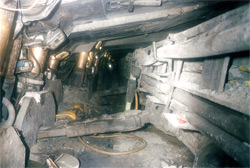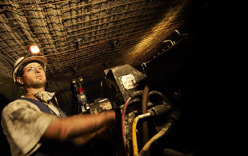AVOIDING AND CORRECTING PROBLEMS
d) CORRECTION
Excessive Roof to Floor Closure
 This can result from lengthy face stoppages, localised areas of high stress or weak strata or inadequate support design. If conditions allow, the
easiest and probably the least costly corrective measure is to continue production as quickly and continuously as possible, including increasing
production time if it is not already continuous. There is a time factor involved in roof to floor closure so the aim of increasing production time
is to move the face to a new fully open (i.e. freshly mined) position as quickly as possible, before the closure becomes too great a problem. As long
as the shearer can still pass beneath the supports, the supports are not iron bound, gate road equipment still has adequate clearance and the roof does
not actually fail in front of the supports, then rapid closure is acceptable.
This can result from lengthy face stoppages, localised areas of high stress or weak strata or inadequate support design. If conditions allow, the
easiest and probably the least costly corrective measure is to continue production as quickly and continuously as possible, including increasing
production time if it is not already continuous. There is a time factor involved in roof to floor closure so the aim of increasing production time
is to move the face to a new fully open (i.e. freshly mined) position as quickly as possible, before the closure becomes too great a problem. As long
as the shearer can still pass beneath the supports, the supports are not iron bound, gate road equipment still has adequate clearance and the roof does
not actually fail in front of the supports, then rapid closure is acceptable.
If it is decided to continue production there is also an option to increase the cutting height, within the limits of the equipment, to allow greater closure to take place before it becomes a major problem. This is especially an option where the full seam is not normally being taken, but in thinner seams may entail cutting some stone.
The risk taken in continuing production without further action is that any forced stoppage which then occurs (e.g. from equipment breakdown) may result in worse conditions resulting than would have been the case if the face had been stopped and alternative action taken when the problem first became evident.
 If the closure is a result of greater floor heave than expected, this may cause the AFC to tilt, in which case continuing production may not be an option because the AFC attitude may cause the shearer to cut too deep into the floor.
If the closure is a result of greater floor heave than expected, this may cause the AFC to tilt, in which case continuing production may not be an option because the AFC attitude may cause the shearer to cut too deep into the floor.
If it is decided that it is necessary to stop production and take additional action to reduce roof lowering, the options available are the same as those for roof failure, described below, but are easier to carry out and can be done with less preparation work in many cases.
If the excessive closure is a result of inadequate support design, there may not be any option but to continue production, or to abandon production altogether and recover the face equipment, possibly to be replaced with adequate equipment later. This may not be an economic option for many operations who would then have to struggle on in frequently poor conditions. In such cases maximising production time available would be important to try and keep the longwall moving forward.

